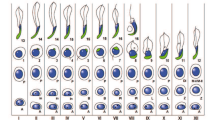Summary
The numbers of each different cell type in the human seminiferous epithelium were determined throughout the 6 stages of the cycle in both semithin and ultrathin sections obtained from 15 young adult men with normal testicular histology. Up to 4 types of A spermatogonia (Ad, Ap, Al and Ac) were distinguished. In addition, the DNA nuclear content of seminiferous epithelium cells was determined on Feulgen-stained sections. Both Ad and Ap spermatogonia showed a 2c DNA content and were present in the 6 stages of the cycle, though their numbers decreased in stages III–V. Both Al and Ac spermatogonia showed a DNA content varying from 2c to 4c. Al spermatogonia were observed in stages III–V; their numbers plus those of Ad spermatogonia in these stages were similar to the numbers of Ad spermatogonia in the other stages lacking in Al spermatogonia. Ac spermatogonia appeared in stages III–VI and their numbers plus those of Ap spermatogonia in stages III–V were similar to the numbers of Ap spermatogonia in the other stages lacking in Ac spermatogonia. The results suggest that Ad spermatogonia are the stem cells. Some of them replicate their DNA; during this replication they appeared as Al spermatogonia. Al spermatogonia divide, giving rise to both Ad and Ap spermatogonia. Some Ap spermatogonia replicate their DNA; during this process they are transformed into Ac spermatogonia which divide, giving rise to B spermatogonia.
Similar content being viewed by others
References
Clermont Y (1963) The cycle of the seminiferous epithelium in man. Am J Anat 112:35–51
Clermont Y (1966) Renewal of spermatogonia in man. Am J Anat 118:509–524
Chowdhury AK, Steinberger E (1977) “In vitro” 3H-thymidine labeling pattern and topographic distribution of spermatogonia in human seminiferous tubules. In: Troen P, Nankin HR (eds) The testis in normal and infertile men. Raven Press, New York, pp 69–83
Floderus S (1944) Untersuchungen über den Bau der menschlichen Hypophyse mit besonderer Berücksichtigung der quantitativen mikromorphologischen Verhältnisse. Acta Pathol Microbiol Scand [Suppl] 53:1–276
Holstein AF, Wartenberg H (1970) On the morphology of human spermatogenesis. In: Holstein AF, Horstmann E (eds) Morphological aspects of Andrology. Grosse Verlag, Berlin, pp 8–12
Holstein AF, Roosen-Runge EC (1981) Atlas of human spermatogenesis. Grosse Verlag, Berlin
Johnson L, Petty CS, Neaves WB (1981) A new approach to quantification of spermatogenesis and its application to germinal cell attrition during human spermiogenesis. Biol Reprod 25:217–226
Johnson L, Petty CS, Neaves WB (1983) Further quantification of human spermatogenesis: germ cell loss during postprophase of meiosis and its relationship to daily sperm production. Biol Reprod 29:207–215
Johnson L, Petty CS, Neaves WB (1984) Influence of age on sperm production and testicular weights in men. J Reprod Fertil 70:211–215
Paniagua R, Nistal M, Amat P, Rodriguez MC, Alonso JR (1986) Quantitative differences between variants of A spermatogonia in man. J Reprod Fertil 77:669–673
Rowley MJ, Berlin JD, Heller CG (1971) The ultrastructure of four types of human spermatogonia. Z Zellforsch Mikrosk Anat 112:139–157
Schulze W (1978a) Licht-und elektronenmikroskopische Studien an den A Spermatogonien von Männern mit intakter Spermatogenese und bei Patienten nach Behandlung mit Antiandrogenen. Andrologia 10:307–320
Schulze W (1978b) Zum Problem der morphologischen Charakterisierung von Spermatogonientypen beim Erwachsenen. Verh Anat Ges (Jena) 72:539–540
Schulze C (1979) Morphological characteristics of the spermatogonial stem cells in man. Cell Tissue Res 198:191–199
Steinberger E (1970) Comment on presentation of Y Clermont. In Rosemberg E, Paulsen CA (eds) The human testis. Plenum Press, New York, p 60
Wing TY, Christensen AK (1982) Morphometric studies on rat seminiferous tubules. Am J Anat 165:13–25
Author information
Authors and Affiliations
Additional information
This work was supported by a grant from the “Comisión Asesora de Investigación Científica y Técnica” Madrid, Spain
Rights and permissions
About this article
Cite this article
Paniagua, R., Codesal, J., Nistal, M. et al. Quantification of cell types throughout the cycle of the human seminiferous epithelium and their DNA content. Anat Embryol 176, 225–230 (1987). https://doi.org/10.1007/BF00310055
Accepted:
Issue Date:
DOI: https://doi.org/10.1007/BF00310055




